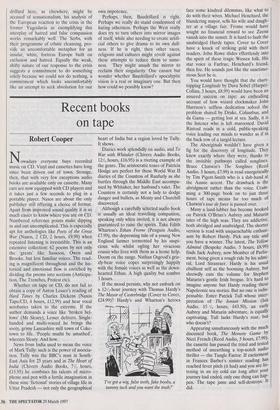Excess and irony to the rescue
Mark Bevir
THE PERFECT CRIME by Jean Baudrillard Versa, £35, £12, pp. 156 T. he perfect crime would be without vic- tim, weapon, motive, or perpetrator. Jean Baudrillard, a leading French post- modernist, sees the murder of reality as Close to the perfect crime. We have done away with the idea of a reality lurking out there, behind our images of it. But there never was any such reality; we cannot unravel the processes by which it has van- ished behind innumerable images; we have no clear motive for getting rid of it; and we cannot say who exactly is getting rid of it.
New, from the philosopher who brought You the Gulf War as an illusion, the mur- der of reality! Baudrillard likes to shock With sound-bites, but behind the sound- bites there is intellectual substance. Post- modern philosophy rejects the idea of the real on the grounds that we can have access Only to out views of the world, not to a reality by which to judge different views of the world. A 19th-century naturalist, P. H. Gosse, argued that God created the world 5,000 years ago including within it those geological and fossil traces that suggest it is more than 5,000 years old. All we have are traces compatible with a number of rival hypotheses. We cannot know if the traces Imply what they seem to or whether God put them there. Most post-modernists accept that we find traces of reality in our beliefs, but they insist we have no way of getting outside our rival sets of beliefs to identify this reality. Our beliefs, as images of reality, exist: reality itself does not. . The excitement of The Petfect Crime lies In the provocative study of modern culture that Baudrillard weaves around the famil-
iar post-modern elimination of reality. He provides a penetrating study of the way technology affects the cultural, social and political life of western societies in the late 20th century. Earlier generations, he tells us, believed in an illusion: they thought the world had a real meaning and a real moral- ity which human beliefs, arts and culture might reflect. Today we are swamped with so many images, each with its own mean- ing, its own morality, that we have lost faith even in this illusion of the real. Modern technologies have done much more than post-modern philosophy to kill the real. We live in a world of proliferating images; a world where we can go into a shop while watching ourselves doing so on a monitor, where we can act out our marital problems on a chat-show, where we can record a con- cert and listen to it years later, where every possibility can be realised at any time in some medium or other. The world of the image has become more real than the world of the real at the same time as post- modernism has shown the world of the real to be a mere image. Our brave new world is one where everything is both possible and an illusion. Everything is visible and transparent without any meaning or moral- ity lurking behind it. Nothing has any par- ticular significance, so nothing can be dismissed as insignificant. 'Banality is threatened with its hour of glory.'
To ward off the banal, we must use excess and irony. Madonna's use of these things is what makes her appropriate as an icon of our times. The opening up of every conceivable possibility in any number of virtual realities makes all things equal, thereby undermining otherness. Even the sexes are becoming more and more similar: whereas seduction artfully highlighted the difference of male and female, liberation emphasises their natural sameness. Madonna, however, creates a hypersexual sex. She mimics all sexual roles in extreme forms so as to parody traditional views of sexual difference. In a world of sexual indifference, where we have no other to deliver us from our bodies, she struggles to deliver herself by means of a panoply of almost sadistic accessories.
Baudrillard warns us that if we fail to use excess and irony we are in danger of creating a new order of hatred and false compassion. Once we lose the illusion of the real, then if we see everything as equal- ly banal, we fall prey to a culture of indifference and sameness. Paradoxically, however, this very culture makes us long for passion and otherness; it makes us idealise artificial others whom we then can hate or care for. We turn with hatred on other sexes, races, cultures, and the like; and we turn with a false compassion to the victims of our hatred to feed them our cul- ture of indifference while we feed on the energy of their misfortune. Although Bau- drillard here, as elsewhere, might be accused of sensationalism, his analysis of the European reaction to the crisis in the former Yugoslavia as exemplifying this interplay of hatred and false compassion works remarkably well. The Serbs, with their programme of ethnic cleansing, pro- vide an uncomfortable metaphor for an insular, white, fortress Europe built on exclusion and hatred. Equally the weak, shifty nature of our response to the crisis suggests a commitment to do something solely because we could not do nothing, a commitment which looks uncomfortably like an attempt to seek absolution for our own impotence.
Perhaps, then, Baudrillard is right. Perhaps we really do stand condemned of hating otherness. Perhaps the West really does try to turn others into mirror images of itself, while also needing to create artifi- cial others to give drama to its own dull- ness. If he is right, then other races, religions and cultures might revolt against these attempts to reduce them to same- ness. They might smash the mirror to reclaim their singularity. One cannot but wonder whether Baudrillard's apocalyptic vision is a real or imaginary one. But then how could we possibly know?



































































 Previous page
Previous page